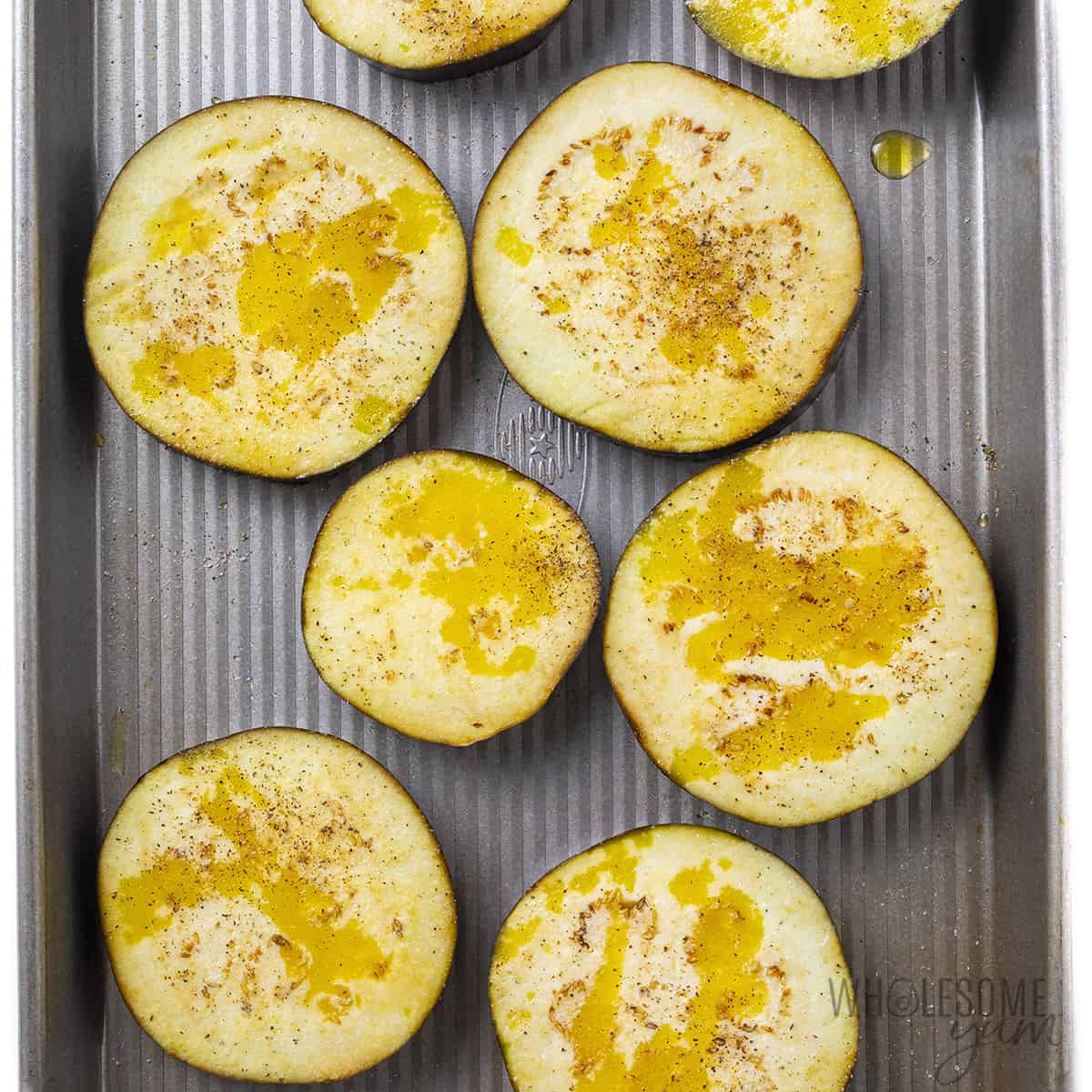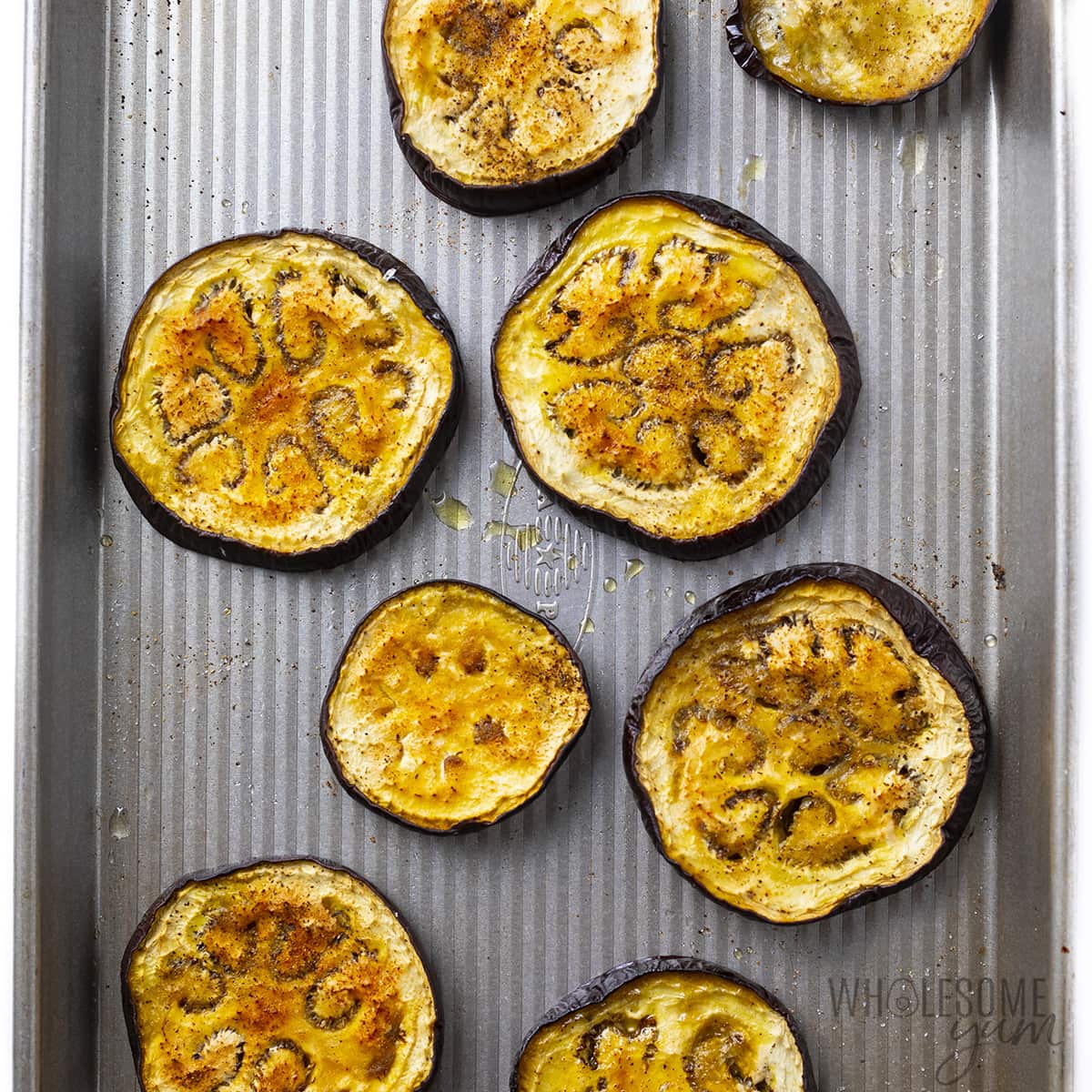This oven roasted eggplant recipe makes the perfect healthy addition to just about any meal. I kept the seasonings basic on these roasted eggplant slices, so that they can be used in a wide variety of ways. Turn them into eggplant Parmesan with marinara and mozzarella cheese. Or use them instead of pasta as lasagna layers (eggplant lasagna!). Or just serve them on the side of some chicken (or other idas below). You really can’t go wrong. I’ll show you how to cut eggplant and how to cook eggplant — everything you need to know about roasting eggplant!
Eggplant is one of those veggies that people often have strong opinions about. And I get it. I wasn’t always a big eggplant fan. But when you drizzle the slices with a generous amount of olive oil and season them correctly, they get caramelized in the oven and they are irresistible!
Everyone should have a basic baked eggplant recipe in their back pocket — and this is it.
While the skin of a small young eggplant is edible, the skin becomes bitter on larger or older eggplants and should be peeled. When in doubt, the answer to, “Do you peel eggplant before cooking?” is yes, peel it. Use a vegetable peeler or paring knife to remove the skin.

Should You Salt Eggplant First?
No, you don’t have to salt your eggplant, because most eggplants today are bred to avoid bitterness. However, if your eggplant is large, it’s more likely to be bitter, so you can salt it if you like. To do this, sprinkle the eggplant slices generously with salt — at least 1 teaspoon of salt per eggplant — and place into a colander over the sink to drain for an hour. (It seems like a lot of salt, but this is necessary for the eggplant to release enough moisture and its bitterness along with it.) Then, rinse with water and proceed with the roasted eggplant recipe as written.
- Store: Store roasted eggplant slices in the refrigerator for 3-5 days. Let them cool after you roast them and then place them in layers in an airtight container.
- Meal prep: You can roast eggplant in advance, but I don’t recommend slicing and storing the raw slices, because they will turn brown.
- Reheat: Warm up baked eggplant in the oven at 350 degrees F. (I use a lower temperature for reheating than for roasting, so that they don’t burn.)
- Freeze: This oven roasted eggplant recipe freezes well! After cooking eggplant, let it cool. Then, you can freeze the slices in a single layer on a parchment paper lined baking sheet. When they are frozen solid, transfer the slices to a freezer bag and store for up to 3-4 months. Thaw before reheating.

How To Roast Eggplant In The Oven
This section shows how to cook eggplant slices in the oven, with step-by-step photos and details about the technique, to help you visualize it. For full instructions, including amounts and temperatures, see the recipe card below.
- Slice the eggplant. See above for instructions and tips.
- Season. Arrange eggplant on a baking sheet (or two if you don’t have room). Once you’ve laid out the slices in a single layer, drizzle them with olive oil and season them with sea salt, garlic powder, and black pepper. Flip over the slices and repeat the oil and seasonings. (You can brush the oil on if you prefer.)
- Roast the eggplant. Cook them until they are soft, golden, and starting to caramelize.


How to Prepare an Eggplant (Roasting/Peeling & Salting)
FAQ
Do you leave the skin on eggplant when you bake it?
Does eggplant need to be soaked before baking?
What is the secret to cooking eggplant?
Should I peel my eggplant for eggplant parmesan?
Is it necessary to peel an eggplant?
To get right down to it, no, it is not necessary to peel an eggplant. There are times when keeping the skin of the eggplant on can create a tough texture or bitter taste, which is why some people peel it off for ease. The skin, however, is completely safe and edible, and contains important nutrients, says Taste of Home .
What is the best way to cook eggplant?
Sautéing eggplant with olive oil appears to be beneficial to health as it positively affects the composition of phenolic compounds present in eggplant and has a different impact on the adjustment of the colon microbiota and the functionality of this food.
How do you peel eggplant?
Use a vegetable peeler or paring knife to remove the skin. The flesh discolors soon after peeling, so only peel eggplants right before using. Here’s how to prepare eggplant for cooking: Cut off the top and blossom ends, then cut the eggplant into ½-inch slices or ¾-inch cubes, unless your recipe states otherwise.
Can you eat eggplant skin after peeling?
While the eggplant skin is edible, removing the skin lessens the bitterness of the vegetable. After peeling the eggplant, consider spritzing the veggie with lemon juice and salt to preserve color and remove moisture: 1. Prevent oxidation: Cut eggplants turn brown after being exposed to air.
